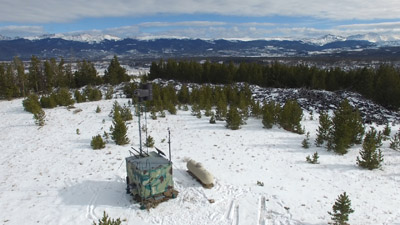Did you know that Colorado has had modified weather since the 1950s? There are many ways that we modify weather, but one of the most common is called cloud seeding. Colorado is an especially important state for cloud seeding projects and research because so many states in our region depend on Colorado snowpack for water.

What is cloud seeding?
Cloud seeding is a weather modification practice that aims to increase the amount of precipitation that falls from clouds. It works by introducing particles into certain types of clouds. These particles act as nuclei that attract tiny water droplets, creating a base for snowflakes to form. The Colorado Water Conservation Commission’s Weather Modification Program uses silver iodide particles to seed clouds, although dry ice, liquid propane, and even table salt can also be used. Cloud seeding typically occurs between November-March and only works to increase snowfall from certain types of naturally forming clouds – cloud seeding cannot create snow clouds in clear skies.
Early research
Colorado scientists have conducted weather modification operations and research since the 1950s. Several of these research reports are available in our digital repository:
- Analysis of climatological data for the spring cloud-seeding over north-central Colorado (Northern Colorado Natural Resources Association, 1952) analyzes data gathered from a cloud seeding project that took place from March 1-June 1, 1951 in the Cache la Poudre, Big Thompson, and St. Vrain watersheds east of the Continental Divide.
- Cloud seeding opportunity recognition (CSU Dept. of Atmospheric Science, 1967) explains the results of a cloud seeding experiment conducted in the mountains near Leadville starting in 1959.
- Snowpack augmentation by cloud seeding in Colorado and Utah (CSU Water Resources Planning Fellowship, 1979) examines the current status of precipitation augmentation in Colorado and Utah to provide the reader with a sense of how precipitation augmentation is going to be used in the Upper Colorado River Basin.
1972 Legislation
In 1972, the Colorado General Assembly passed the Weather Modification Act, which required weather modification projects to be regulated and permitted by the Colorado Water Conservation Board. A 1971 report to the General Assembly titled, “Controlling weather modification activities,” anticipates this legislation and contains recommendations for regulation and reporting. After the 1972 legislation passed, Colorado created a program to distribute permits for cloud seeding and other weather modification projects that still exists today.
Sunset review reports put together by the Department of Regulatory Agencies provide an overview of the regulatory requirements for weather modification projects and evaluate the necessity of continued regulations. The most recent sunset review was published in 2017 and recommends that the weather modification regulations continue until 2033.
Interstate agreements
Colorado is home to the headwaters of eight major river basins, so downstream states rely on Colorado snowpack for their water. Because of this responsibility, many new cloud seeding permits were issued in response to the drought that began in the southwest in the early 2000s.
One of these interstate projects is described in Final cloud seeding summary report 2006-2007: San Juan Mountains Weather Modification Program, published by the Colorado Water Conservation Board in 2009. The California Six Agency Committee, the Central Arizona Water Conservation District, the Southern Nevada Water Authority, and the Colorado Water Conservation Board all contributed funding for three cloud seeding operations to increase snowpack in the Colorado mountains that would eventually increase the water supply downstream.
Current projects
Cloud seeding has been in the news recently because of a new cloud seeding project starting in St. Vrain Creek watershed, as well as for studies that are being conducted for a project in the Yampa and White River Basins. These new projects join seven permitted weather modification programs in Colorado:
- Central Colorado River Basins,
- Vail/Beaver Creek Program,
- Upper Gunnison River Basin Program,
- Grand Mesa,
- San Juan Mountains,
- North Platte Basin Airborne Cloud Seeding Project, and
- North Platte Basin Ground-Based Program.
For information and a map of current cloud seeding projects, visit Colorado’s Weather Modification Program website.
- Colorado’s Governors: Ralph L. Carr - July 11, 2025
- Celebrating Colorado’s immigrant heritage - June 27, 2025
- Colorado’s Scenic and Historic Byways: Guanella Pass - June 6, 2025